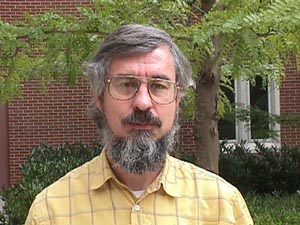Professor Bruce J. MacLennan
Bruce J. MacLennan, Ph.D. is Associate Professor, Dept. of Electrical Engineering & Computer Science, University of Tennessee. His main research areas are Emergent Computation and Connectionism.
Emergent Computation is computation that exploits the self-organizing, collective, competitive, and cooperative phenomena arising from the interaction of large numbers of units obeying local dynamical laws. More briefly, emergent computation is the study of how high-level representation and processing of information can emerge from the interactions of large numbers of simple processors. His emergent computation research is concentrated in three areas: Universally Programmable Intelligent Matter, Field Computation, and Artificial Life.
Connectionism is an approach to artificial intelligence and cognitive modeling based on the use of simplified neural network models. His connectionist research is concentrated in three overlapping areas: Neurodynamics Models, Connectionist Epistemology, and Continuous Computation.
Bruce earned a BS in mathematics (with honors, 1972) from Florida State University, and an MS (1974) and PhD (1975) in computer science from Purdue University. He joined Intel Corporation in 1975 where, as a Senior Software Engineer, he worked on the architectures of the 8086 and the iAPX-432, an advanced object-oriented, multi-processing, multi-programming processor with capability-based addressing and user-definable typing.
In 1979 he returned to academia, joining the Computer Science faculty of the Naval Postgraduate School (Monterey, CA), where he was an Assistant Professor (1979–83), an Associate Professor (1983–7), and Acting Chair (1984–85). At NPS he investigated novel models for massively parallel computing and artificial intelligence. Since 1987 he has been a member of the Computer Science faculty of the University of Tennessee, Knoxville.
In the mid-80s Bruce redirected his research toward natural computation, that is, computation inspired by or occurring in nature. One aspect of this work has been to understand the representation and processing of information in the brains of humans and other animals. In particular, in an attempt to understand the sources of the flexibility and efficiency of neural information processing, he has developed models of continuous information representation and processing, which are a significant departure from traditional theories of knowledge. These ideas are especially relevant to AI, but also to neuroscience, cognitive science, and philosophy, and so he has been active in the interdisciplinary intersection of these research areas and has collaborated with scholars in each of them.
Bruce’s investigation into these alternative models of information processing led to the realization that conventional digital computers are inadequate for realizing the full potential of natural computation, and therefore that alternative, more brain-like, technologies should be developed. Therefore he has investigated non-Turing models of computation, in particular field computation. Field computation represents information in terms of spatial continua of low-precision continuous quantities, and is a model for cortical maps in the mammalian brain. He gave invited lectures on the technological aspects of this work in Japan (Mar., Dec. 1991), and on its neuropsychological aspects in Spain (Jul. 1994).
Another aspect of natural computation is the creation and processing of information in populations of organisms, which can be a model of emergent information processing in loosely-organized groups of agents or processors. Bruce has been especially interested in the emergence of self-organized communication systems, and this research produced the first demonstration (1989) of the evolution of communication in a population of machines. In recognition of this research he was elected a Fellow of the Institute for Advanced Studies of the Collegium Budapest, and in 1997 he spent the summer there investigating the evolution of communication and combinator-based models of pre-biotic chemical evolution.
As a consequence, in the late 90s he began a new research project, a theoretical investigation of the application of molecular computing based on Curry-Feys combinatory logic to nanostructure synthesis and control. (This work was eventually supported by an NSF Nanoscale Exploratory Research Grant.) The emphasis again was on the use of a non-traditional model of computation for an application to which it was especially suited.
In summary, for the last two decades his research has focused on novel models of computation intended to better exploit physical processes for computation, and to provide new concepts of information representation and processing in natural and artificial systems. His research now focuses on natural computation and self-organization. In June 2005, he presented an invited paper, “The Nature of Computation — Computation in Nature”, at a workshop on “Natural Processes and New Models of Computation” organized by the University of Bologna. Most recently, in September 2006, he gave an invited presentation Super-Turing or Non-Turing? at a workshop Future Trends in Hypercomputation in Sheffield (UK).
Bruce has more than 50 refereed journal articles and book chapters and has had two books published (one in its third edition). He has made more than 60 invited or refereed presentations.
Bruce authored Functional Programming: Practice and Theory, Principles of Programming Languages: Design, Evaluation, and Implementation, A Review of Field Computation, Evolutionary Psychology, Complex Systems, and Social Theory, Protophenomena: The Elements of Consciousness and their Relation to the Brain, A Summary of the History of AI Before Computers, The U-Machine: A Model of Generalized Computation, Aesthetics in Software Engineering, Making Meaning in Computers: Synthetic Ethology Revisited, Extending the Concept of Computation, and Consciousness in Robots: The Hard Problem and Some Less Hard Problems. Read the full list of his publications!
Recently, he was invited to become the founding Editor-in-Chief of the International Journal of Nanotechnology and Molecular Computation (scheduled to begin publication in January 2009).
Bruce is a member of American Association for the Advancement of Science (AAAS), the International Neural Network Society (INNS), the Institute of Electrical and Electronic Engineers (IEEE) and IEEE Computer Society, the International Society for Nanoscale Science, Computation and Engineering, the International Society for Neoplatonic Studies (ISNS), and the Society for Ancient Greek Philosophy (SAGP). Since 1988 he has been a BBS Associate (qualified commentator) for the journal Behavioral and Brain Sciences.
